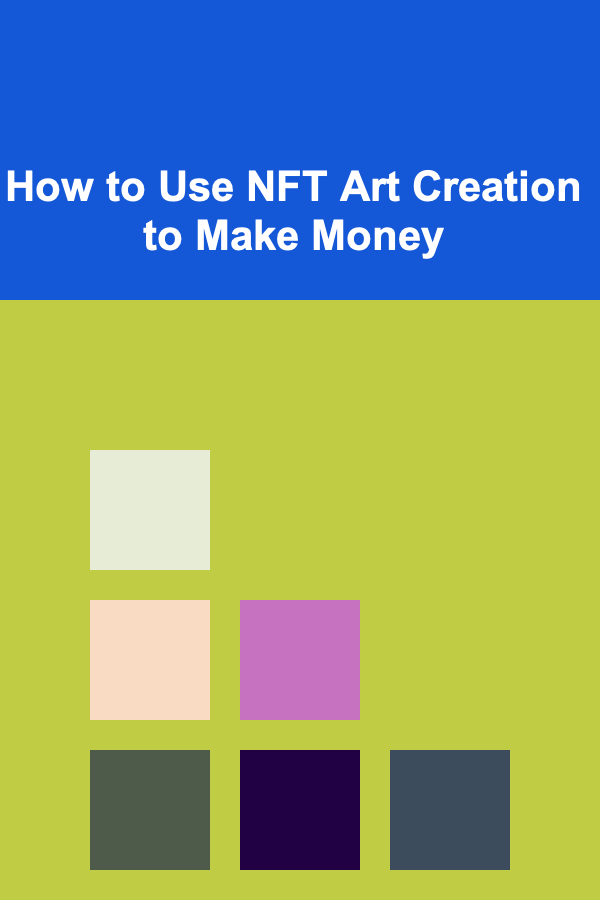
How to Use NFT Art Creation to Make Money
ebook include PDF & Audio bundle (Micro Guide)
$12.99$9.99
Limited Time Offer! Order within the next:

In the rapidly evolving digital landscape, one of the most innovative and profitable trends emerging in the world of art is NFTs (Non-Fungible Tokens). These blockchain-based assets are revolutionizing how art is bought, sold, and appreciated. NFT art creation, once a niche concept, is now a significant way for artists to monetize their work and engage with a global audience. This article will explore in-depth how NFT art creation works, how artists can use it to make money, and strategies for maximizing profits in the NFT space.
Understanding NFTs and NFT Art
Before diving into the process of creating and selling NFT art, it's essential to understand what NFTs are and how they relate to digital art.
What is an NFT?
An NFT, or Non-Fungible Token, is a type of digital asset that exists on a blockchain, typically the Ethereum blockchain, though other blockchains like Solana, Binance Smart Chain, and Tezos also support NFTs. NFTs are unique in that they cannot be replicated or exchanged on a one-to-one basis like cryptocurrencies such as Bitcoin or Ethereum. Each NFT has a distinct value and identity, often represented by a digital asset such as an image, video, audio file, or any other form of digital content.
Unlike traditional cryptocurrencies, where each unit is identical and can be exchanged for another of the same value, NFTs are non-fungible, meaning each token has its own unique data that distinguishes it from others. This makes NFTs ideal for representing ownership of unique digital items, including art.
What is NFT Art?
NFT art refers to digital artwork that is sold and purchased as an NFT. These artworks can include images, animations, music, and even 3D models. The primary allure of NFT art is that it provides a way for digital creators to prove ownership and authenticity of their work. With the blockchain technology behind NFTs, artists can guarantee that their creations are original and that the buyer owns a verifiable piece of unique content.
How NFTs Work for Artists
NFTs work by embedding metadata within the blockchain. When an artist creates an NFT, they effectively "mint" it, attaching the artwork to a blockchain, which records and stores all the details of the transaction. The buyer of the NFT then becomes the verified owner of that artwork, which is secured with the unique ID of the blockchain. This verification of ownership is crucial because, for digital artists, it solves the problem of authenticity that has plagued the digital art world for years.
Step-by-Step Guide to Creating NFT Art
Now that you have an understanding of NFTs and how they relate to digital art, let's walk through the process of creating and minting NFT art.
Step 1: Choose Your Medium and Concept
NFT art can take many forms, ranging from traditional drawings, paintings, and photography to digital sculptures, animations, and even virtual reality experiences. The first step in creating NFT art is deciding on the medium and concept for your artwork.
- 2D Art: Traditional digital art, like drawings, paintings, and illustrations.
- 3D Art: Models or sculptures created using 3D software like Blender or Cinema 4D.
- Animations and GIFs: Short animated clips or looping animations that can be sold as NFTs.
- Music and Audio: Musicians can mint their songs or soundtracks as NFTs, offering them as exclusive or limited-edition content.
The concept behind your artwork is equally important. Many NFT artists create pieces that speak to popular trends, cultural movements, or unique ideas that will resonate with a specific audience. Researching current NFT trends can help you align your art with what collectors are actively seeking, but your originality and unique voice are also what will make you stand out.
Step 2: Create Your Artwork
Once you have your concept, the next step is creating the artwork. For digital artists, this usually involves using software like Adobe Photoshop, Illustrator, Procreate, or Blender, depending on the type of art being created.
- Illustrators and Digital Painters: Software like Photoshop or Procreate allows for detailed 2D artwork, ranging from paintings to detailed illustrations.
- 3D Artists: Use programs like Blender or Autodesk Maya to create 3D models, sculptures, or animations.
- Photographers: For photographers, NFTs provide a way to sell limited-edition digital prints with verified ownership.
When creating digital art for NFTs, it's essential to consider the format of your file. Most NFT platforms support common formats such as JPEG, PNG, GIF, MP4, and others.
Step 3: Choose the Right Blockchain
While Ethereum is the most commonly used blockchain for NFTs, it's not the only option. The blockchain you choose will affect your artwork's transaction costs, environmental impact, and the platform's popularity. Some other popular blockchains for NFTs include:
- Ethereum: The most widely used blockchain for NFTs, but it also has higher gas fees (transaction costs) due to its popularity.
- Solana: Known for its faster and cheaper transactions, making it a popular choice for artists looking to avoid high gas fees.
- Tezos: An eco-friendly blockchain that has gained popularity due to its low energy consumption and low minting costs.
- Binance Smart Chain (BSC): Another popular blockchain with lower transaction fees.
The blockchain you choose will determine where you can mint and sell your NFTs, so it's important to research which platforms support your chosen blockchain.
Step 4: Mint Your Artwork as an NFT
Minting is the process of creating an NFT by uploading your artwork onto a blockchain. This process attaches your digital artwork to a unique token, which can then be bought, sold, or traded.
To mint your NFT, you will need to:
- Create a Wallet: You'll need a digital wallet, such as MetaMask or Trust Wallet, to store your NFTs and cryptocurrency. The wallet will be linked to your chosen blockchain.
- Choose a Marketplace: Some popular NFT marketplaces include OpenSea, Rarible, Foundation, and Mintable. Each platform has its unique features and audience, so you should choose one that aligns with your art and goals.
- Upload Your Artwork: On your chosen marketplace, you can upload your digital art file and provide the necessary details, such as the title, description, and any special attributes.
- Set Royalties: One of the major advantages of NFTs is the ability to set royalties. This means you can earn a percentage of every subsequent sale of your NFT, ensuring ongoing revenue as your artwork is resold.
- Mint and Pay Fees: After uploading your art, you will mint it by paying a small fee (called a "gas fee") to the blockchain to process and record your NFT.
Once minted, your artwork will be available for sale, and the blockchain will verify your ownership and the buyer's ownership.
How to Make Money with NFT Art
Now that you have created and minted your NFT, the next question is: How do you make money from it? There are several ways to monetize your NFT art, each with its strategies and opportunities.
1. Selling NFTs on Marketplaces
The most direct way to make money with NFTs is by selling them on an NFT marketplace. After minting your NFT, you can list it for sale at a fixed price or auction it to the highest bidder. Some popular NFT marketplaces include:
- OpenSea: One of the largest and most popular NFT marketplaces. OpenSea supports a wide range of digital art and collectibles.
- Rarible: Another decentralized marketplace that allows artists to create and sell NFTs. It also has a unique community governance model where users can vote on platform decisions.
- Foundation: A more curated NFT platform, known for high-quality art and exclusive drops.
Once your NFT is sold, you receive the payment in cryptocurrency, typically Ethereum or the blockchain's native currency.
2. Offering Limited Editions
Limited edition NFTs are highly sought after by collectors, and offering a set number of NFTs for a particular artwork can create a sense of rarity and urgency. By selling a limited number of editions, you can increase the perceived value of your artwork.
3. Secondary Sales and Royalties
One of the most appealing aspects of NFTs for artists is the ability to earn royalties from secondary sales. When an NFT is resold on the marketplace, you, as the original creator, can set a royalty percentage (usually between 5% and 10%). This means that every time your NFT is resold, you earn a commission, allowing for continuous income streams as your work gains in popularity.
4. Collaborations and Partnerships
NFT art creation doesn't have to be a solitary endeavor. Collaborating with other artists, musicians, or influencers can amplify your reach and create new opportunities for selling NFTs. For instance, creating NFTs for a well-known brand, artist, or influencer can boost your visibility and lead to more sales.
5. Exclusive NFT Drops
An "NFT drop" refers to the release of a new set of NFTs for sale, often with limited availability or special bonuses. Exclusive drops create excitement and hype around an artwork, driving demand and increasing the likelihood of a successful sale. Many NFT artists engage in drop events to attract attention and gain recognition in the community.
Marketing Your NFT Art
Simply creating and minting your NFT art is not enough to guarantee sales. To succeed in the NFT space, you need to actively promote your work. Here are some effective marketing strategies:
- Social Media: Platforms like Twitter, Instagram, and TikTok are essential for promoting your NFT art. Share behind-the-scenes content, announcements of new drops, and engage with the NFT community.
- Community Engagement: Join NFT-focused Discord groups and online communities to network with other artists, collectors, and potential buyers.
- Collaborations: Collaborating with other creators and influencers can help increase the visibility of your NFT art.
- Email Marketing: Build an email list of collectors and fans to notify them about upcoming NFT drops and special promotions.
Conclusion
NFT art creation provides an innovative and exciting way for artists to monetize their work in the digital age. With the right approach, artists can create, mint, and sell their artwork as NFTs, earning money directly from their creations while maintaining ownership and control. By following the steps outlined in this article, embracing new opportunities, and engaging with the NFT community, artists can tap into a thriving market and generate a sustainable income from their digital artwork.
The NFT space is still evolving, and new technologies and platforms are constantly emerging. However, the potential for artists to thrive in this new digital economy is immense. Whether you're an established artist or a newcomer, the NFT art world is full of opportunities to explore and profit from your creativity.
Other Products

5 Common Mistakes to Avoid When Applying for Remote Positions
Read More
How to Build a Soundproof Home Gym
Read More
How to Leverage SEO for Organic Traffic in the Pet Supplies Niche
Read More
How to Personalize Storage Solutions for Your Child
Read More
How to Stage Outdoor Areas for Year-Round Appeal
Read More